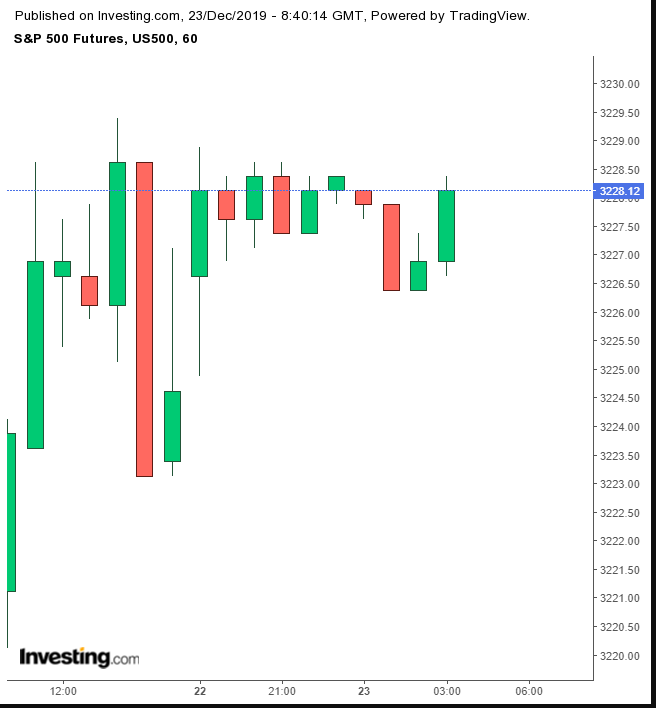- 2019 set to be best year for equities this decade
- Trade optimism continues to spur markets, yet no signed agreement in sight
- Still no corroboration global economic slowdown has turned around
Key Events
With investor attention shifting toward the opcoming holidays, U.S. futures for the Dow Jones, NASDAQ and S&P 500 are relatively flat, on muted volume. European stocks are slightly higher while yields have taken a step back.
Global Financial Affairs

After U.S. indices, including the S&P 500, logged their biggest gains since September on a weekly basis last week, this morning U.S. contracts have been holding steady. A small decline in bank shares was enough to pressure the STOXX Europe 600 Index today, after it hit an all-time high on Friday, for the first time since 2015. Investors appear to be taking profits ahead of the year-end.
Asian shares started the week mixed. China’s Shanghai Composite plunged, (-0.1.40%), its biggest drop in six weeks after the China Integrated Circuit Industry Investment Fund, which is state backed, said it would trim its stakes in some tech companies. Australia’s ASX 200, (-0.46%), was the second worst performer. Japan's TOPIX was down 0.21%, while remaining major indices were flat.

Yields, including for the benchmark 10-year Treasury, dropped away from a resistance in place since the Nov. 7 highs. Technically, rates are above the long-term downtrend line since November 2018 but need to overcome the 2.00 key level to convince us of the breakout.
As December winds down, 2019 is setting up to be the best year for risk assets in a decade. Major global central banks joined forces to accommodate record prices and the two economic superpowers, the U.S. and China, are said to be on track for a trade deal.
To that end, China has announced it will cut import tariffs on a broad range of goods including food, consumer items and some semiconductor chips beginning Jan. 1, thereby continuing Beijing’s drive to lower trade barriers and spur domestic demand. The signing of the first phase of the U.S.-China trade deal is set for sometime in early January.
Still, amid all the good news, it pays to remember that there is, as yet, no confirmation from either prices or data that the global economic slowdown has bottomed. As far as we’re concerned, this spectacular run for markets is a central bank-injected sugar high. It's the only rational way we can make sense of investor tolerance of a still-unresolved, dodgy and unreliable U.S.-China trade deal, which may never be signed and which even in its first phase remains hollow of any specifics related to core issues.

Even with a hard-Brexit back on the table, the pound found support for a third day. Cable is rebounding from the 1.3000 level—as predicted.
Saudi Arabia and Kuwait are said to be headed for a deal to renew oil production along their shared border, increasing output by up to half a million barrels a day.

Crude is falling for a second day, with the price threatening to return below the psychological $60 level.
Up Ahead
- On Monday, U.K. Prime Minister Boris Johnson aims to muscle Brexit legislation through Parliament before the Jan. 31 deadline.
- Chinese Premier Li Keqiang hosts a summit on Tuesday in Chengdu, focused on trade. Attendees will include Japanese Prime Minister Shinzo Abe and South Korean President Moon Jae-in.
- Most global stock markets will be closed Wednesday for Christmas. Australia, Canada, Germany and U.K. markets are also shut on Dec. 26.
- U.S. initial jobless claims will be released on Thursday.
- Japan's retail sales and industrial production data are due out on Friday.
- Also on Friday, China releases industrial profits.
Market Moves
Stocks
- The Stoxx Europe 600 Index declined 0.1%.
- Futures on the S&P 500 Index were little changed.
- The UK’s FTSE 100 Index declined 0.1%.
- The MSCI All-Country World Equity Index was little changed.
- The MSCI Emerging Markets Index was little changed.
Currencies
Bonds
- The yield on 10-year Treasuries fell two basis points to 1.90%.
- The yield on two-year Treasuries advanced less than one basis point to 1.63%.
- Germany’s 10-year yield declined two basis points to -0.27%.
- Britain’s 10-year yield sank three basis points to 0.749%.
- Japan’s 10-year yield climbed less than one basis point to 0.016%.
